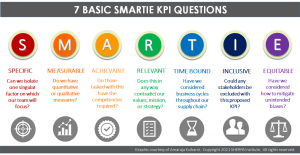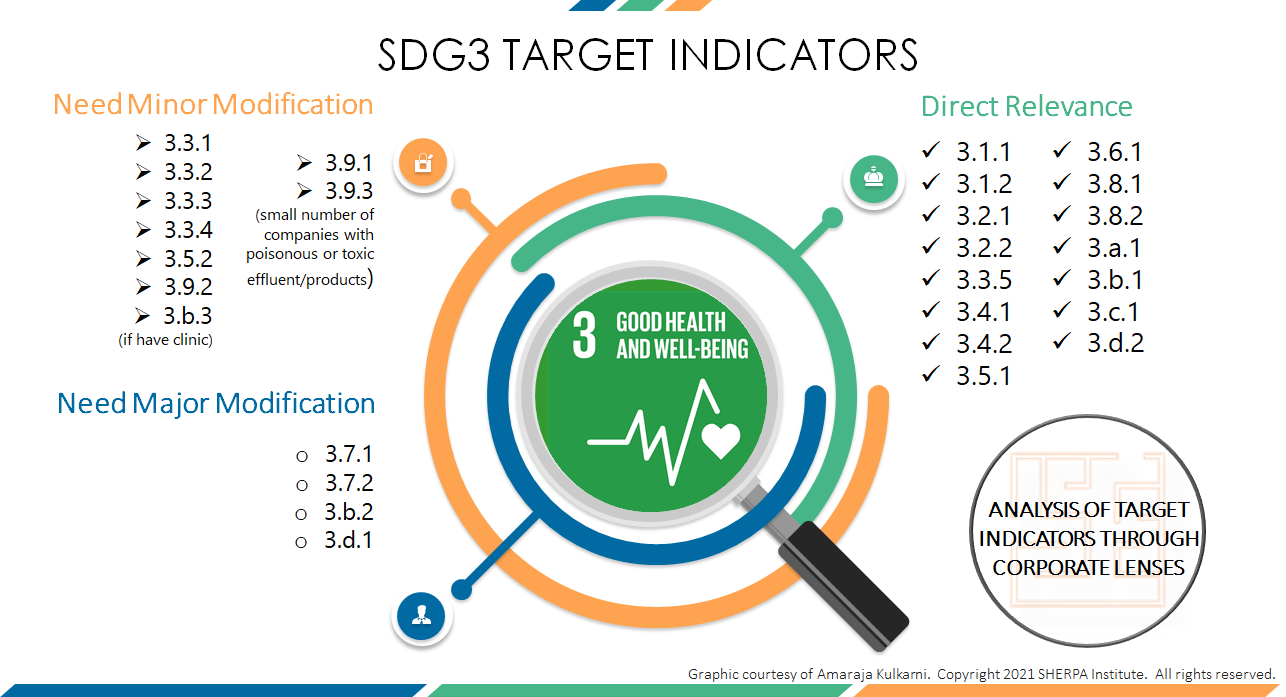9/20/2021
Thank you for your interest in Good Health and Well-Being! Did you know that 80% of healthcare problems arise due to non-clinical issues? All types of businesses, not just those in the healthcare industries, are needed to impact the SDG3 Targets. The non-clinical issues affecting well-being are social determinants of health (SDoH) including education, employment and job security, working conditions, food security, housing, transportation, and more. Keep these SDoH* in mind, as they are factors that businesses of all types and sizes can impact.
SDG3 has 13 Targets, with 28 indicators for measurement of progress, all simple measures with no compound indicators as some other SDGs have. Around a quarter may be used with various modification for most businesses. Two have no relevance outside of companies with poisonous or toxic effluent or products. A handful of the Target Indicators have very limited relevance for our readers. By changing measurements from the national level to within the facility or community, a bit more than half of these Target Indicators can be adapted to be relevant for most businesses.
Given that the United Nations indicators are articulated at a national level, we see the need for adaptation of Target Indicators across all the SDGs. You might be surprised to learn that the SDGs were ratified in 2015 without any Target Indicators. Can you imagine launching a strategic initiative in your business without planning to measure progress? In 2017, the Target Indicators were added; and they are periodically reviewed and updated. But they are not written for businesses.
In our Corporate Guidebook, chapter by chapter, we propose possible business key performance indicators (KPIs) which are specific, measurable, actionable, relevant, and timebound (SMART). Considering the topics in SDoH, the addition of inclusive and equitable (SMARTIE) is a business imperative for SDG3. We will use industry scenarios as examples to share KPIs that would work in business for each Target. You have the opportunity to use these examples as guides to create your own KPIs for your own business’s situation and strategy.

You will need to create SDG3 KPIs that are relevant to you and your company, and it is not just SHERPA Institute telling you this. One of the leading global consultancies, PwC, explains “SDG relevant KPIs the all-important bridge between prioritizing the Goals, embedding them into business strategy and action planning, and, in turn, producing better reporting” (2018, p. 21).
When you’ve prioritized the SDG3 Targets that you can impact, and a strategy with opportunities your team will pursue, you will develop your own SMARTIE KPIs. This is a strategic activity, with diverse stakeholders from all functional areas and deliberate inclusion of all levels and interest groups. Consider a PPE manufacturer, whose business objective is to meet the yearly forecasted demand. The pandemic has thrown a wrench into production plans. The firm should get advice beyond senior executives, gathering input from sales, customer service and warehouse employees.
Your KPIs should be both leading and lagging, which serve different purposes. Lagging indicators measure performance after activities have occurred; for example, last quarter’s production. There is nothing that can be done at this point to change those results. However, it may influence reactionary short-term plans. In response to lower output in the previous quarter, a firm could offer overtime for additional shifts, which can be detrimental to health.
While lagging indicators allow us to react, it is also important to have leading indicators. These measure the conditions you’ve put in place to achieve your objectives. This allows you time to make improvements and stay on track. Using more examples from manufacturing, leading indicators include forecasted state of the supply chain (which suffered in the early parts of the pandemic), days inventory of raw materials, and scheduled factory downtime. For every business objective, it is important to have a minimum of two KPIs, both leading and lagging.
In our next Insights Article, we will share one example of how SDoH* can apply to any business. We show how we’ve modified an SDG3 Target Indicator for business producing both leading and lagging SMARTIE KPIs. If you have any questions or thoughts on this topic, we invite you to share below. Has your business produced SDoH KPIs for SDG3? We’d love to hear from you! Thank you again for your interest.
*To learn more about SDoH, please read the article series by SDG3 Co-Author, Dr. Elissa Torres. You may also want to read SDG3 Co-Author Marilyn Johnson’s series on how to incorporate SDoH and the SDGs into your career!
PwC. (2018). SDG Reporting Challenge 2018. Price Water Cooper. Retrieved from https://www.pwc.com/hu/hu/kiadvanyok/assets/pdf/sdg_reporting_2018.pdf
Copyright 2021 SHERPA Institute. All rights reserved – please cite and link to this web page.


